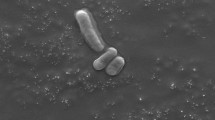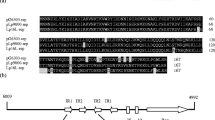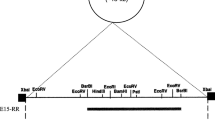Abstract
Analysis of the structural properties of pCC3, a cryptic plasmid from Leuconostoc citreum C4 isolated from kimchi, determined its length as 3,338 bp and revealed three open reading frames (ORFs): ORF1–ORF3. ORF3 showed high homology with a replication initiation protein of the theta-type plasmid pTXL1. The fragment encompassing ORF3 and its upstream sequences (nt 1,299–1,634) was found to contain a functional plasmid replicon. A new shuttle vector, pUCC3E1, was constructed based on pCC3. Using Southern hybridization analysis, no single-stranded DNA intermediate was detected from Leu. citreum harboring pUCC3E1, which indicates that pCC3 replicated via the theta mechanism. The pUCC3E1 could be replicated in E. coli TG1 (5.8 × 104 CFU/μg DNA) and the developed cloning hosts, Leu. citreum C16 (2.1 × 102 CFU/μg DNA) and Leu. citreum GJ7 (8.0 × 101 CFU/μg DNA). pUCC3E1 was stably maintained in Leu. citreum C16 (for 100 generations, ca. 94.2%) in the absence of erythromycin (5 μg/ml).







Similar content being viewed by others
References
Alpert CA, Crutz-Le Coq AM, Malleret C, Zagorec M (2003) Characterization of a theta-type plasmid from Lactobacillus sakei: a potential basis for low-copy-number vectors in lactobacilli. Appl Environ Microbiol 69:5574–5584
An HY, Miyamoto T (2006) Cloning and sequencing of plasmid pIC494 isolated from human intestinal Lactobacillus casei: construction of an Escherichia coli–Lactobacillus shuttle vector. Plasmid 55:128–134
Berthier F, Zagorec M, Champomier-Verges M, Ehrlich SD, Morel-Deville F (1996) Efficient transformation of Lactobacillus sake by electroporation. Microbiology 142:1273–1279
Biet F, Cenatiempo Y, Fremaux C (1999) Characterization of pFR18, a small cryptic plasmid from Leuconostoc mesenteroides ssp. mesenteroides FR52, and its use as a food grade vector. FEMS Microbiol Lett 179:375–383
Biet F, Cenatiempo Y, Fremaux C (2002) Identification of a replicon from pTXL1, a small cryptic plasmid from Leuconostoc mesenteroides subsp. mesenteroides Y110, and development of a food-grade vector. Appl Environ Microbiol 68:6451–6456
Chang JY, Lee HJ, Chang HC (2007) Identification of the agent from Lactobacillus plantarum KFRI 464 that enhances bacteriocin production by Leuconostoc citreum GJ7. J Appl Microbiol 103:2504–2515
Danielsen M (2002) Characterization of the tetracycline resistance plasmid pMD5057 from Lactobacillus plantarum 5057 reveals a composite structure. Plasmid 48:98–103
Foley S, Bron S, Venema G, Daly C, Fitzgerald GF (1996) Molecular analysis of the replication origin of the Lactococcus lactis plasmid pCI305. Plasmid 36:125–141
Frere J, Novel M, Novel G (1993) Molecular analysis of the Lactococcus lactis subspecies lactis CNRZ270 bidirectional theta replicating lactose plasmid pUCL22. Mol Microbiol 10:1113–1124
Gasson MJ (1983) Plasmid complements of Streptococcus lactis NCDO721 and other lactic streptococci after protoplast induced curing. J Bacteriol 154:1–9
Gibson TJ (1984) Studies on the Epstein-Barr virus genome. Ph.D. thesis, Cambridge University, England
Gravesen A, Josephsen J, von Wright A, Vogensen FK (1995) Characterization of the replicon from the lactococcal theta-replicating plasmid pJW563. Plasmid 34:105–118
Gravesen A, von Wright A, Josephsen J, Vogensen FK (1997) Replication regions of two pairs of incompatible lactococcal theta-replicating plasmids. Plasmid 38:115–127
Hayes F, Daly C, Fitzgerald GF (1990) Identification of the minimal replicon of Lactococcus lactis subsp. lactis UC317 plasmid pCI305. Appl Environ Microbiol 56:202–209
Holo H, Nes IF (1989) High-frequency transformation, through electroporation, of Lactococcus lactis subsp. cremoris grown with glycine in osmotically stabilized media. Appl Environ Microbiol 55:3119–3123
Jeong SJ, Park JY, Lee HJ, Kim JH (2007) Characterization of pFMBL1, a small cryptic plasmid isolated from Leuconostoc mesenteroides SY2. Plasmid 57:314–323
Kanatani K, Tahara T, Oshimura M, Sano K, Umezawa C (1995) Identification of the replication region of Lactobacillus acidophilus plasmid pLA103. FEMS Microbiol Lett 133:127–130
Khan SA (1997) Rolling-circle replication of bacterial plasmids. Microbiol Mol Biol Rev 61:442–455
Kiewiet R, Bron S, de Jonge K, Venema G, Seegers JF (1993) Theta replication of the lactococcal plasmid pWVO2. Mol Microbiol 10:319–327
Kim JH, Woo SH (1995) Expression of Bacillus lichenifoemis α-amylase gene in Lactobacillus casei strains. J Microbiol Biotechnol 5:257–263
Lee JH, Halgerson JS, Kim JH, O’Sullivan DJ (2007) Comparative sequence analysis of plasmids from Lactobacillus delbrueckii and construction of a shuttle cloning vector. Appl Environ Microbiol 73:4417–4424
Lucey M, Daly C, Fitzgerald GF (1993) Identification and sequence analysis of the replication region of the phage resistance plasmid pCI528 from Lactococcus lactis subsp. cremoris UC503. FEMS Microbiol Lett 110:249–256
Noirot-Gros MF, Ehrlich SD (1994) Detection of single-stranded plasmid DNA. Methods Mol Genet 3:370–378
O’Sullivan DJ, Klaenhammer TR (1993) Rapid miniprep isolation of high-quality plasmid DNA from Lactococcus and Lactobacillus ssp. Appl Environ Microbiol 59:2730–2733
Park WJ, Lee KH, Lee JM, Lee HJ, Kim JH, Lee JH, Chang HC, Chung DK (2004) Characterization of pC7 from Lactobacillus paraplantarum C7 derived from kimchi and development of lactic acid bacteria-Escherichia coli shuttle vector. Plasmid 52:84–88
Park JH, Lee MH, Jung JH, Kim JH (2005) pIH01, a small cryptic plasmid from Leuconostoc citreum IH3. Plasmid 54:184–189
Sambrook J, Fritsch EF, Maniatis T (1989) Molecular cloning: a laboratory manual, 2nd edn. Cold Spring Harbor Laboratory, Cold Spring Harbor
Sánchez C, Hernandez de Rojas A, Martinez B, Arguelles ME, Suarez JE, Rodriguez A, Mayo B (2000) Nucleotide sequence and analysis of pBL1, a bacteriocin-producing plasmid from Lactococcus lactis IPLA 972. Plasmid 44:239–249
Shareck J, Choi Y, Lee B, Miguez CB (2004) Cloning vectors based on cryptic plasmids isolated from lactic acid bacteria: their characteristics and potential applications in biotechnology. Crit Rev Biotechnol 24:155–208
Siezen RJ, Renckens B, van Swan I, Peters S, van Kranenburg R, Kleerebezen M, De Vos WM (2005) Complete sequences of four plasmids of Lactococcus lactis subsp. cremoris SK11 reveal extensive adaptation to the dairy environment. Appl Environ Microbiol 71:8371–8382
Titok M, Suski C, Dalmais B, Ehrlich SD, Janniere L (2006) The replicative polymerase PolC and DnaE are required for theta replication of the Bacillus subtilis plasmid pBS72. Microbiology 152:1471–1478
Yannish-Perron C, Vieira J, Messing J (1985) Improved M13 phage cloning vectors and host strains: nucleotide sequence of the M13mp18 and pUC19 vectors. Gene 33:103–119
Zúñiga M, Pardo I, Ferrer S (1996) Nucleotide sequence of plasmid p4028, a cryptic plasmid from Leuconostoc oenos. Plasmid 36:67–74
Acknowledgment
This work was supported by grant number RTI05-01-01 from the Regional Technology Innovation Program of the Ministry of Knowledge Economy (MKE), Republic Korea.
Author information
Authors and Affiliations
Corresponding author
Rights and permissions
About this article
Cite this article
Chang, J.Y., Chang, H.C. Identification of a replicon from pCC3, a cryptic plasmid from Leuconostoc citreum C4 derived from kimchi, and development of a new host–vector system. Biotechnol Lett 31, 685–696 (2009). https://doi.org/10.1007/s10529-009-9912-9
Received:
Revised:
Accepted:
Published:
Issue Date:
DOI: https://doi.org/10.1007/s10529-009-9912-9




